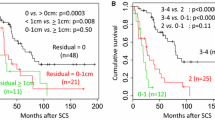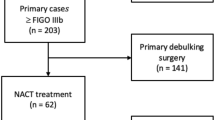Abstract
Background
The standard treatments of patients with platinum-sensitive recurrent ovarian cancer (ROC) remains poorly defined. Chemotherapy (CT) and secondary cytoreductive surgery (SCS) represent both valid options, even if several studies demonstrated a greater survival benefit, with survival rates up to 62 months, for platinum-sensitive patients undergoing complete SCS. The purpose of the present study was to develop a predictive model, named SeC-Score (SeC-s), to assess the risk of optimal SCS, including, for the first time in literature, HE4.
Methods
All patients affected by suspicious ROC at radiologic imaging, referred to the Department of Gynecology of Campus Bio-medico of Rome, were prospectively included in the study. The preoperative variables considered in our predictive model were: age, residual tumour (RT) at primary cytoreduction (0 vs. >0 cm), preoperative CA125 and HE4, and ascites at recurrence. After exploratory laparotomy, patients were submitted to secondary SCS (Group A) or addressed to CT (Group B).
Results
A total of 135 patients with ROC were considered for the analysis. Preoperative CA125, HE4, ascites, and RT at first surgery were found statistically significant and included into a multivariate logistic regression model to determine the risk to not optimal SCS. In the overall cohort of patients, SeC-s reported sensitivity and specificity of 82 and 83 %, respectively (PPV = 0.79, NPV = 0.81).
Conclusions
Our data support the use of SeC-s to preoperative triage patients suitable of optimal SCS, even if external validation is needed.



Similar content being viewed by others
References
Ledermann JA, Raja FA. Clinical trials and decision-making strategies for optimal treatment of relapsed ovarian cancer. Eur J Cancer. 2011;47:S104–15.
Van de Laar, et al. Cytoreductive surgery followed by chemotherapy versus chemotherapy alone for recurrent platinum-sensitive epithelial ovarian cancer (SOCceR trial): a multicenter randomised controlled study. BMC Cancer. 2014;14:22.
Al Rawahi T, Lopes AD, Bristow RE. Surgical cytoreduction for recurrent epithelial ovarian cancer. Cochrane Database Syst Rev. 2013;28:2.
Plotti F, Scaletta G, Aloisi A, Luvero D, Capriglione S, Miranda A, Montera R, De Cicco Nardone C, Terranova C, Angioli R. Quality of life in platinum-sensitive recurrent ovarian cancer: chemotherapy versus surgery plus chemotherapy. Ann Surg Oncol. 2015 Jan 13.
Heintz AP, Odicino F, Maisonneuve P, et al. Carcinoma of the ovary. Int J Gynecol Obstet. 2003;83:(1 Suppl):135–66.
Harter P, du Bois A, Hahmann M, Hasenburg A, Burges A, Loibl S, et al. Surgery in recurrent ovarian cancer: The Arbeitsgemeinschaft Gynaekologische Onkologie (AGO)DESKTOP OVAR Trial. Ann Surg Oncol. 2006;13(12):1702-10.
Harter P, Bois AD, Hahmann M, et al. Surgery in recurrent ovarian cancer: The Arbeitsgemeinschaft Gynaekologische Onkologie (AGO) DESKTOP OVAR trial. Ann Surg Oncol. 2006;13:1702–10.
Tian WJ, Chi DS, Sehouli J, Trope CG, Jiang R, Ayhan A, et al. A risk model for second- ary cytoreductive surgery in recurrent ovarian cancer: an evidence-based proposal for patient selection. Ann Surg Oncol. 2012;19:597–604.
Plotti F, Capriglione S, Terranova C, Montera R, Aloisi A, Damiani P, Muzii L, Scaletta G, Benedetti-Panici P, Angioli R. Does HE4 have a role as biomarker in the recurrence of ovarian cancer? Tumour Biol. 2012;33(6):2117-23. doi:10.1007/s13277-012-0471-7. Epub 2012 Aug 9. PubMed PMID: 22875782.
Angioli R, Capriglione S, Aloisi A, Guzzo F, Luvero D, Miranda A, Damiani P, Montera R, Terranova C, Plotti F. Can HE4 predict platinum response during first-line chemotherapy in ovarian cancer? Tumour Biol. 2014;35(7):7009-15.
Angioli R, Plotti F, Capriglione S, Aloisi A, Montera R, Luvero D, Miranda A, Cafà EV, Damiani P, Benedetti-Panici P. Can the preoperative HE4 level predict optimal cytoreduction in patients with advanced ovarian carcinoma? Gynecol Oncol. 2012 Dec 7.
Eisenhauer EA, Therasse P, Bogaerts J, Schwartz LH, Sargent D, Ford R, Dancey J, Arbuck S, Gwyther S, Mooney M, Rubinstein L, Shankar L, Dodd L, Kaplan R, Lacombe D, Verweij J. New response evaluation criteria in solid tumours: revised RECIST guideline (version 1.1). Eur J Cancer. 2009;45(2):228-47.
Angioli R, Plotti F, Capriglione S, Montera R, Damiani P, Ricciardi R, Aloisi A, Luvero D, Cafà EV, Dugo N, Angelucci M, Benedetti-Panici P. The role of novel biomarker HE4 in endometrial cancer: a case control prospective study. Tumour Biol. 2012 Nov 20.
Angioli R, Miranda A, Aloisi A, Montera R, Capriglione S, De Cicco Nardone C, Terranova C, Plotti F. A critical review on HE4 performance in endometrial cancer: where are we now? Tumour Biol. 2013 Sep 26.
Angioli R, Capriglione S, Aloisi A, Luvero D, Cafà EV, Dugo N, Montera R, De Cicco Nardone C, Terranova C, Plotti F. REM (risk of endometrial malignancy): a proposal for a new scoring system to evaluate risk of endometrial malignancy. Clin Cancer Res. 2013;19(20):5733-9.
Muzii L, Bellati F, Manci N, Zullo MA, Angioli R, Panici PB. Ringer’s lactate solution remains in the peritoneal cavity after laparoscopy longer than expected. Fertil Steril. 2005;84(1):148–53.
Peduzzi P, Concato J, Kemper E, Holford TR, Feinstein AR. A simulation study of the number of events per variable in logistic regression analysis. J Clin Epidemiol. 1996;49:1373–9.
Lee CK. Impact of secondary cytoreductive surgery on survival in patients with platinum sensitive recurrent ovarian cancer: analysis of the CAPLYPSO trial. Gynecol Oncol. 2015;136(1):18–24.
Chan JK, Sherman AE, et al. Influence of gynecologic oncologists on the survival of patients with endometrial cancer. J Clin Oncol. 2011;29:832–8.
Plotti F, Capriglione S, Miranda A, Scaletta G, Aloisi A, Luvero D, Ricciardi R, Terranova C, De Cicco Nardone C, Angioli R. The impact of gynecologic oncology training in the management of cancer patients: is it really necessary? A prospective cohort study. Eur J Obstet Gynecol Reprod Biol. 2015;184:19–23.
Fanfani F, Monterossi G, Fagotti A, Gallotta V, Costantini B, Vizzielli G, Petrillo M, Carbone MV, Scambia G. Positron emission tomography-laparoscopy based method in the prediction of complete cytoreduction in platinum-sensitive recurrent ovarian cancer. Ann Surg Oncol. 2014.
Author information
Authors and Affiliations
Corresponding author
Rights and permissions
About this article
Cite this article
Angioli, R., Capriglione, S., Aloisi, A. et al. A Predictive Score for Secondary Cytoreductive Surgery in Recurrent Ovarian Cancer (SeC-Score): A Single-Centre, Controlled Study for Preoperative Patient Selection. Ann Surg Oncol 22, 4217–4223 (2015). https://doi.org/10.1245/s10434-015-4534-z
Received:
Published:
Issue Date:
DOI: https://doi.org/10.1245/s10434-015-4534-z




